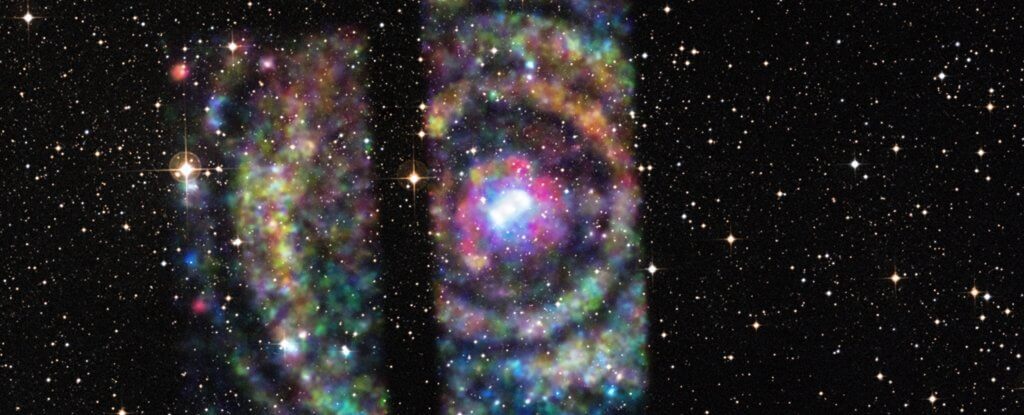- Get link
- X
- Other Apps

Fast radio bursts (FRB) are one of the most mysterious mysteries in the universe. Despite the fact that the nature of absolutely all FRB astronomers is still unknown, scientists seem to have finally figured out from what an amazing environment some of the most talked about FRBs recently appeared. It's about repeating signals FRB 121102.
For the first time FRB 121102 signals started talking in November 2012, but scientists have taken several years to narrow down the search for their unusual nature. The most rapid radio bursts, as a rule, appeared only once, which made the calculation of their source an impossible task, but the feature of FRB 121102 was that these signals are repeated.
This gave scientists a unique opportunity to study these signals. FRBs are radio pulses with a duration of several milliseconds, but at times they have the energy of 500 million suns. Since most often these radio pulses are not repeated, it is practically impossible to predict them. As, however, and to trace their source. That is why scientists have so far been unable to determine their true nature.
Signals FRB 121102 did not cease to amaze researchers for several years. In March 2016, astronomers announced the discovery in the archival data of telescopes of information about 10 rapid radio bursts from the same region. In December 2016, 6 more FRB 121102 signals were detected, and in August 2017 - another 15. This allowed scientists to determine the location of the source of these signals. It turned out to be the star-forming region of one dwarf galaxy, located more than three billion light years from the Earth.
An international group of researchers, studying data from different radio telescopes, was able to narrow the search even more narrowly and eventually reach a single conclusion. Scientists are more sure than ever that the source of FRB 121102 is a neutron star. And apparently, this star is in an extremely extreme environment - either very close to a black hole, or inside a very powerful nebula. Such conclusions of the researchers were prompted by the fact that these radio signals were "twisted".
About their work, experts shared in the journal Nature, where they report that signals FRB 121102 were almost completely polarized. When these polarized signals pass through a magnetic field, they are twisted, and the stronger this magnetic field, the stronger they twist. This feature is called the Faraday effect and allows researchers to learn more about the nature of certain waves. In the case of signals FRB 121102, their polarization plane turned out to be the most twisted from ever observed, which indicates that they passed through a very powerful magnetic field.
"The only known sources in our galaxy, which have the same power as the FRB 121102, twisted by a plane of polarization, are in the galactic center and are located in a very dynamic region next to a massive black hole. Perhaps the source FRB 121102 is in a similar environment in its galaxy, "says Daniel Michilli of the University of Amsterdam.
"Also, the peculiarity of the swirling plane of polarization can be explained if their source is located in a very powerful nebula remaining after the supernova explosion," he adds.
Observation explains the role of the neutron star. It is believed that these objects arise as a result of supernova explosions. If the mass of the star is above a certain value, then instead of a supernova, it turns into a black hole.
Neutron stars are very small and very dense objects. And when they rotate, they radiate radio pulses. A certain type of neutron stars, called magnetars, has an extremely powerful magnetic field and is capable of generating emissions - similar to how the sun produces solar flares. They were also considered by scientists as a possible source of fast radio pulses, but observations showed that the most powerful flares of these objects were four orders of magnitude lower in power than FRB 121102. As a result, scientists came to the conclusion that the source of the FRB 121102 is the usual type of neutron star. At the same time, researchers plan to continue their work and try to find out more in what environment they appeared.
"We will continue to observe and monitor how the properties of these bursts change over time. Within these observations, we will try to find out which of the assumptions turned out to be true - the neutron star is near the black hole, or it is inside a very powerful nebula, "says Jason Hessels of the same University of Amsterdam.
At the same time, we still do not know what is the source of a dozen other observed radio bursts. They did not repeat, as it was with FRB 121102, so scientists suggest that FRB 121102 may be unique in its kind, while others may have different sources.
The article is based on materials .
- Get link
- X
- Other Apps
Comments
Post a Comment